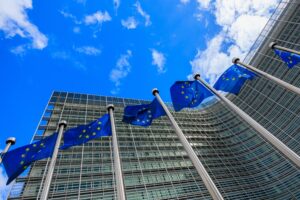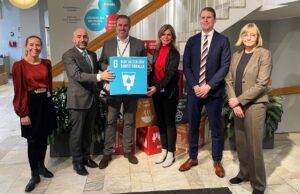- SIWI – Leading expert in water governance
- /
- Latest
- /
- How source-to-sea knowledge can benefit the Asia-Pacific Region
How source-to-sea knowledge can benefit the Asia-Pacific Region

With the Asia Pacific Water Summit fast approaching on 23 – 24 April 2022, we spoke to Yumiko Yasuda about why the conference must focus on source-to-sea perspectives. Yasuda, from the Global Water Partnership, will represent the Action Platform for Source-to-Sea Management at the Summit.
Could you tell us a little about the Asia-Pacific Water Summit and what the objectives of the event are?
The Asia Pacific Water Summit is an event which takes place every two to three years and specifically targets heads of states, ministers and high-level policy- and decision-makers from the Asia-Pacific region, to help them understand the importance of addressing water issues to achieve the global Sustainable Development Goals (SDGs). Decision-making and leadership examples are showcased, as well as examples of successful practice and innovation, which led to concrete results and substantial impact for the water sector. This will be the fourth summit which was planned to be held last year but had to be rearranged due to the Covid-19 pandemic.
The Global Water Partnership is a partner to the Asia-Pacific Water Forum, which is the main partnership forum to collaborate on the water agenda in the Asia Pacific region. Our Asia-Pacific regional partnerships are part of the governing council of Asia-Pacific Water Forum and very much engaged in the preparation for the Asia-Pacific Water Summit. We are co-organizing six sessions, and speaking in an additional two sessions, bringing our expertise from across the region.
Why is it important that source-to-sea perspectives are presented at the summit?
Source-to-sea management, which addresses the linkages between land, freshwater, coasts and the ocean through upstream-downstream cooperation and cross-sectoral coordination, is critically important for addressing key development challenges in the Asia-Pacific region. Many countries face high levels of pollution from plastics, agricultural runoff and untreated wastewater. Biodiversity loss, and sinking deltas are also widespread and the region needs rapid progress on both climate mitigation and adaptation. These are source-to-sea challenges – they can only be solved by reaching across the typical land, freshwater, coastal and marine boundaries.
Like in many other ‘water’ conferences in the past, the Asia-Pacific Water Summit has been primarily focused solely on the issue of freshwater and has excluded the connection with land, coasts and the ocean. With the growing global recognition of the need for source-to-sea management if we are to achieve SDG 6 on water as well as the other SDGs, this year’s summit is a great opportunity to convey the need for and benefits of source-to-sea management directly to relevant decision- and policy-makers in the Asia-Pacific region. Including source-to-sea perspectives In the Asia-Pacific Water Summit will increase awareness across all stakeholders in the region.
Could you give an example of why source-to-sea management is important to the Asia-Pacific region?
The Asia Pacific region hosts nine out of the 10 most polluted rivers in the world when it comes to plastic waste and suffers from generally high levels of contamination. The region has high population density, hosts two of the most populated countries in the world, has many kilometres of coastline and draws benefits from rich marine resources making it a global ‘hotspot’ for source-to-sea action. Given this, it is inevitable to implement source-to-sea management in the Asia- Pacific.
The Global Water Partnership is a global network that promotes the use of integrated water resources management for a water secure world. Facilitating cross-sectoral coordination and a multistakeholder approach is our ‘bread and butter’, which is also essential to implementing the source-to-sea approach. We currently have four active regional partnerships in Asia that can bring the source-to-sea agenda to stakeholders and foster cooperation across sectors and scales.
For instance, the Yangtze River in China is reported as second on the global list for levels of plastic pollution entering the ocean. Addressing the pollution issue for this large river in the region requires an approach that brings together different sectoral actors and stakeholders to collaborate on finding source-to-sea solutions. The Yangtze Water Partnership is embarking on utilizing China’s ‘River Chief System’ as a vehicle to tackle pollution over the entire Yangtze River. The River Chief System is a policy innovation that is implemented across China, allowing coordination across jurisdictional boundaries. By integrating ‘source to sea’ thinking into this policy innovation, we hope to bring a larger impact along the river and to the sea in minimizing and ultimately preventing pollution from entering waterways and the ocean.
What are you hoping to achieve through the S2S Platform’s presence at the event?
The Asia-Pacific Water Summit is the gathering of leaders of all the countries in the region, where they share important issues related to water resources management in the region. It is a prime opportunity for raising awareness of new innovations and important trends in the leaders of Asia-Pacific. Bringing attention to source-to-sea and the importance of linkages between freshwater and marine health to these leaders is crucial.
Initially, the mention of the land, freshwater, coastal and marine linkages and the source-to-sea approach were missing from the design of the Asia-Pacific Water Summit. Through active engagement in the planning process, the Global Water Partnership, together with S2S Platform partners, was able to include the source-to-sea topic in the ‘Water and Environment from Source to Sea’ thematic session. Source-to-sea will be presented by the UNSG Special Envoy for the Ocean H.E. Peter Thomson. Inclusion of source-to-sea in the thematic session provides a pathway to bring source-to-sea messages to the overall outcome of the Summit.
The source-to-sea perspective will also be brought forward by Ambassador Thomson in the final high level integrated session of the summit. As a native of Fiji and coming the Asia Pacific region, he has special insights that can speak directly to the concerns of the region’s leadership.
What would be the ideal outcome be for source-to-sea, coming out of the event?
I am hoping that the declaration coming from the Asia-Pacific Water Summit will include commitments to the source-to-sea approach by the region’s leaders. High-level commitment is crucial for successful initiation and implementation of the source-to-sea approach. I really hope the discussion during the Summit will garner interest in, raise awareness of and motivate action by political leaders so we see more consideration of the linkages between land, freshwater, coasts and the ocean taken by decision and policy makers. It is important as the Summit declaration is a key political declaration, which gives a direction for all countries and leaders.
I also hope that the message of source-to-sea is communicated to the next series of key high-level water events such as the Dushanbe Water Process, the High-Level Water Symposium and UN Ocean Conference in Lisbon and onto the 2023 UN Water Conference. Momentum is growing for the source-to-sea approach and we want to see it continue throughout 2022 and into 2023. I am hoping that we can set a good example of such commitment coming out from the Asia Pacific region.
What is source-to-sea management?
The term source-to-sea is used to describe how land, freshwater, coasts and oceans are linked, meaning that what happens in one place will unavoidably have implications elsewhere. For too long, it has been common to turn a blind eye to consequences downstream, which has aggravated problems like plastic pollution, ecosystem degradation and climate change. But source-to-sea management, where upstream and downstream impacts and benefits are taking into account, is increasingly seen as a powerful solution.
Most recent

SIWI Reflections 2025: When water-smart restoration builds change from the ground up
- Freshwater and ecosystems/biodiversity
- Water in landscapes
- Water governance

SIWI Reflections 2025: Shaping SIWI’s future through strategy, collaboration, and renewal
- Water and climate
- Water in landscapes

SIWI Reflections 2025: Shaping water resilience through European policy
- Water and climate
- Water cooperation

SIWI joins the winning consortium to lead EIT Water – Europe’s new innovation community tackling water challenges

Water at the heart of climate action: SIWI shapes the future of the GCAA

SIWI-WASH experts join IVL


